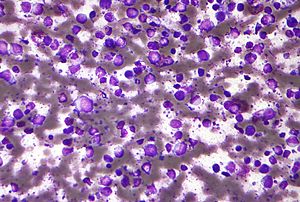Diffuse large B-cell lymphoma
Revision as of 06:43, 25 September 2013 by Michael (talk | contribs) (Michael moved page Diffuse large B cell lymphoma to Diffuse large B-cell lymphoma over redirect: more common)
Diffuse large B cell lymphoma, abbreviated DLBCL, is a very common lymphoma with a poor prognosis.
| Diffuse large B-cell lymphoma | |
|---|---|
| Diagnosis in short | |
 DLBCL - cytology. | |
|
| |
| LM | large lymphoid cells (>=2x resting lymphocyte), nucleolus, sheeting architecture |
| LM DDx | follicular lymphoma, Hodgkin lymphoma, PTLD, primary effusion lymphoma, carcinoma |
| IHC | CD20+, CD10+/-, BCL6+/-, CD45+ |
| Molecular | t(14;18)(q32;q21)/IGH-BCL2 - esp. when arising from follicular lymphoma |
| Site | Lymph node |
|
| |
| Blood work | +/- cytopenia |
| Radiology | lymphadenopathy |
| Prognosis | poor |
| Clin. DDx | metastatic carcinoma, reactive lymphadenopathy, infective lymphadenopathy |
General
- Poor prognosis.
- May arise from follicular lymphoma.
- Most common form of non-Hodgkin lymphoma (in the USA).[1]
- Most common lymphoma of the spleen.[2]
Microscopic
- Large lymphoid cells:
- >= 2x the diameter of a small lymphocytes.
- Marked cell-to-cell variation in size and shape.
- Cytoplasm usually basophilic and moderate in abundance.
- +/-Prominent nucleoli, may be peripheral and/or multiple.
- Not follicular - nodular arrangement.
- Follicular arrangement = follicular lymphoma.
Notes:
- Large bizarre cells can occasionally mimic Reed-Sternberg cells, seen in Hodgkin lymphoma.
Images:
Special subtypes of diffuse large B cell lymphoma
- Primary mediastinal B-cell lymphoma (PMBL) - esp. in young adults.
- T-cell/histiocyte-rich large B cell lymphoma.
- Primary DLBCL of the CNS.
- EBV-positive DLBCL of the elderly.
- DLBCL associated with chronic inflammation.
- Intravascular LBCL.
- ALK-positive LBCL.
- Plasmablastic lymphoma.
- LBCL arising in HHV-8 associated multicentric Castleman disease.
- Primary effusion lymphoma.
- Lymphomatoid granulomatosis.
Differential diagnosis
- Carcinoma.
- Anaplastic large cell lymphoma (ALCL).
- Follicular lymphoma.
- If a nodular architecture is present it is follicular lymphoma.
- Post-transplant lymphoproliferative disorder (PTLD) - in organ transplant recipients.
- Primary effusion lymphoma - seen in HIV infections.
- Mixed cellularity Hodgkin lymphoma - esp. for T-cell/histiocyte-rich large B cell lymphoma.
- B-cell lymphoma, unclassifiable, with features intermediate between diffuse large B-cell lymphoma and classical Hodgkin lymphoma.[4]
IHC
Subclassification
There is a subclassification based on molecular testing:
- Germinal centre (GC) subtype.
- Non-germinal centre (Non-GC) subtype.
The following IHC algorithm has been subsequently developed to reproduce the molecular categorization:[5]
| DLBCL | |||||||||||||||||||||||||
| CD10 -ve | CD10 +ve GC | ||||||||||||||||||||||||
| BCL6 -ve Non-GC | BCL6 +ve | ||||||||||||||||||||||||
| MUM1 -ve GC | MUM1 +ve Non-GC | ||||||||||||||||||||||||
"UHN panel"
- H&E 2 micrometers.
- CD20 -- B cells.
- CD10 -- follicular lymphoma (membrane).
- BCL6 -- follicular lymphoma (nucleus).
- BCL2 -- follicular lymphoma (membrane/cytoplasm).
- MUM1 -- B cells.
- CD21 -- highlight FDC networks if present.
- CD23 -- highlight FDC networks if present.
- MIB1 -- proliferative rate.
- EBER -- EBV.
- CD3 -- T cells (membrane/cytoplasm).
- CD5 -- T cells (membrane).
- Unstained x4.
Molecular
- Rearrangements of BCL6.[6]
- Can be assessed with an ISH break apart probe.
- Translocation typical of follicular lymphoma: t(14;18)(q32;q21)/IGH-BCL2.[7]
Sign out
RETROPERITONEAL MASS, RIGHT, CORE BIOPSIES: - DIFFUSE LARGE B-CELL LYMPHOMA. COMMENT: The tumour consists of cells approximately 2x the size of mature lymphocytes. Mature lymphocytes are intermixed with the tumour. There is no gland formation. Follicle formation is not apparent.
SPLEEN, SPLENECTOMY: - DIFFUSE LARGE B-CELL LYMPHOMA. COMMENT: Architecture: no gland formation, no follicle formation apparent, dyscohesive. Tumour cell size: 1.5-2x resting lymphocyte. Nucleoli: present. Cytoplasm: scant-to-moderate basophilic/grey. Proliferation: mitoses easily identified. Positive stains (tumour cells): CD45, CD20, BCL-2, BCL-6. Negative stains (tumour cells): pankeratin, S-100, MUM-1, CD3, CD5, CD10, CD21, CD30. Ki-67: 20% of cells.
Preliminary
RETROPERITONEAL MASS, LEFT, CORE BIOPSIES: - MORPHOLOGICALLY CONSISTENT WITH LARGE CELL LYMPHOMA -- PENDING IHC. COMMENT: Tumour cells: size ~2x mature lymphocyte, small nucleoli present, moderate quantity of grey/basophilic cytoplasm. Cells intermixed with tumour: mature lymphocytes. Architecture: no gland formation, discohesive, no follicles apparent.
See also
References
- ↑ 1.0 1.1 Mitchell, Richard; Kumar, Vinay; Fausto, Nelson; Abbas, Abul K.; Aster, Jon (2011). Pocket Companion to Robbins & Cotran Pathologic Basis of Disease (8th ed.). Elsevier Saunders. pp. 321. ISBN 978-1416054542.
- ↑ Shimizu-Kohno, K.; Kimura, Y.; Kiyasu, J.; Miyoshi, H.; Yoshida, M.; Ichikawa, R.; Niino, D.; Ohshima, K. (Sep 2012). "Malignant lymphoma of the spleen in Japan: a clinicopathological analysis of 115 cases.". Pathol Int 62 (9): 577-82. doi:10.1111/j.1440-1827.2012.02844.x. PMID 22924843.
- ↑ Cotran, Ramzi S.; Kumar, Vinay; Fausto, Nelson; Nelso Fausto; Robbins, Stanley L.; Abbas, Abul K. (2005). Robbins and Cotran pathologic basis of disease (7th ed.). St. Louis, Mo: Elsevier Saunders. pp. 676 (???). ISBN 0-7216-0187-1.
- ↑ Gualco, G.; Natkunam, Y.; Bacchi, CE. (Jan 2012). "The spectrum of B-cell lymphoma, unclassifiable, with features intermediate between diffuse large B-cell lymphoma and classical Hodgkin lymphoma: a description of 10 cases.". Mod Pathol. doi:10.1038/modpathol.2011.200. PMID 22222636.
- ↑ Choi, WW.; Weisenburger, DD.; Greiner, TC.; Piris, MA.; Banham, AH.; Delabie, J.; Braziel, RM.; Geng, H. et al. (Sep 2009). "A new immunostain algorithm classifies diffuse large B-cell lymphoma into molecular subtypes with high accuracy.". Clin Cancer Res 15 (17): 5494-502. doi:10.1158/1078-0432.CCR-09-0113. PMID 19706817.
- ↑ Online 'Mendelian Inheritance in Man' (OMIM) 109565
- ↑ Vitolo U, Ferreri AJ, Montoto S (June 2008). "Follicular lymphomas". Crit. Rev. Oncol. Hematol. 66 (3): 248–61. doi:10.1016/j.critrevonc.2008.01.014. PMID 18359244.